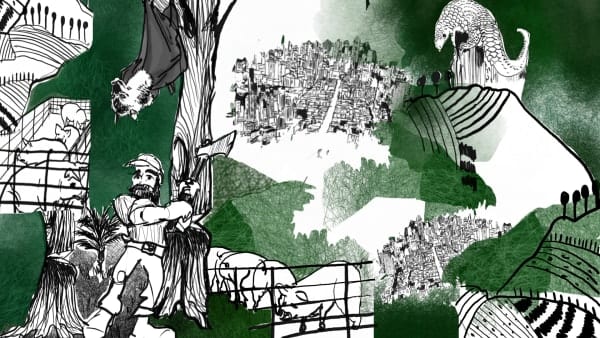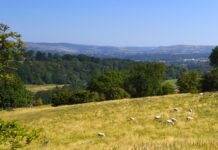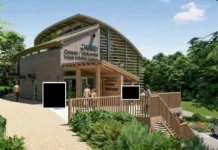

Artistic representation of the impact of land use change on habitat suitable for horseshoe bats. Image credits: Giulia Biasini
Global land-use changes — including forest fragmentation, agricultural expansion and concentrated livestock production — are creating “hotspots” favorable for bats that carry coronaviruses and where conditions are ripe for the diseases to jump from bats to humans, finds a new analysis by researchers at the Politecnico di Milano, University of California, Berkeley and Massey University.
While the exact origins of the SARS-CoV-2 virus remain unclear, scientists believe that the disease likely emerged when a virus that infects horseshoe bats was able to jump to humans, either directly through wildlife-human contact, or indirectly by first infecting an intermediate animal host such as the pangolin. Horseshoe bats are known to carry a variety of coronaviruses, including strains that are genetically similar to ones that cause COVID-19 and Severe acute respiratory syndrome (SARS).
The new study used remote sensing to analyze land use patterns throughout the horseshoe bat’s range, which extends from Western Europe through Southeast Asia. By identifying areas of forest fragmentation, human settlement, and agricultural and livestock production, and comparing these to known horseshoe bat habitat, they identified potential “hotspots”where habitat is favorable for these bat species, and where these so-called zoonotic viruses could potentially jump from bats to humans. The analysis also identified locations that could become easily become hotspots with changes in land use.
“The analyses aimed to identify the possible emergence of new hotspots in response to an increase in one of three land use attributes, highlighting both the areas that could become suitable for spillover and the type of land-use change that could induce hotspot activation,” said study co-author Maria Cristina Rulli, a professor in hydrology and water and food security at the Politecnico di Milano. “We hope these results could be useful for identifying region-specific targeted interventions needed to increase resilience to coronavirus spillovers”.
“Land use changes can have an important impact on human health, both because we are modifying the environment, but also because they can increase our exposure to zoonotic disease,” said study co-author Paolo D’Odorico, a professor of environmental science, policy and management at UC Berkeley. “Every formal land use change should be evaluated not only for the environmental and social impacts on resources such as carbon stocks, microclimate and water availability, but also for the potential chain reactions that could impact human health.”
Most of the current hotspots are clustered in China, where a growing demand for meat products has driven the expansion of large-scale, industrial livestock farming. Concentrated livestock production is particularly concerning because the practice brings together large populations of genetically similar, often immune-suppressed animals that are highly vulnerable to disease outbreaks, the researchers said.
The analysis also found that parts of Japan, the north Philippines, and China south of Shanghai are at risk of becoming hotspots with further forest fragmentation, while parts of Indochina and Thailand may transition into hotspots with increases in livestock production.
Human encroachment into natural habitat can also can indirectly increase exposure to zoonotic disease by reducing valuable biodiversity. When forest lands become fragmented and natural habitats are destroyed, species who require very specific habitat to survive, called “specialists,” may dwindle or even go extinct. Without competition from specialists, “generalist” species, who are less picky about their habitat, can take over.
Horseshoe bats are a generalist species, and have often been observed in areas characterized by human disturbance. Earlier work by Rulli, D’Odorico and study co-author David Hayman has also linked forest fragmentation and habitat destruction in Africa to outbreaks of the Ebola virus.
“By creating conditions that are disadvantageous to specialist species, generalist species are able to thrive,” D’Odorico said. “While we are unable to directly trace the transmission of SARS-CoV-2 from wildlife to humans, we do know that the type of land-use change that brings humans into the picture is typically associated with the presence of these bats who are known to carry the virus.”
While China has been a leader in tree-planting or “greening efforts” over the past two decades, many of the trees have been planted in discontinuous land areas or forest fragments. To tilt the ecological balance back in favor of specialist species, creating continuous areas of forest cover and wildlife corridors are more important than increasing total tree cover.
“Human health is intertwined with environmental health and also animal health,” D’Odorico said. “Our study is one of the first to connect the dots and really drill down into the geographic data on land use to see how humans are coming into contact with species that might be carriers.”
Nikolas Galli of the Politecnico di Milano and David Hayman of Massey University are a co-author of the paper.
This research was supported by the ENI Enrico Mattei Foundation (FEEM), the Cariplo Foundation (SusFeed project 0737 CUP D49H170000300007), Regione Lombardia (RUD0CONV01/ASSO project D44I20002000002), a Royal Society Te Apārangi Rutherford Discovery Fellowship RDF-MAU1701 MAU1701, and the Massey University Foundation.
Politecnico di Milano is a scientific-technological university which trains engineers, architects and industrial designers.
The University has always focused on the quality and innovation of its teaching and research, developing a fruitful relationship with business and productive world by means of experimental research and technological transfer.
Research has always been linked to didactics and it is a priority commitment which has allowed Politecnico Milano to achieve high quality results at an international level as to join the university to the business world. Research constitutes a parallel path to that formed by cooperation and alliances with the industrial system.
Knowing the world in which you are going to work is a vital requirement for training students. By referring back to the needs of the industrial world and public administration, research is facilitated in following new paths and dealing with the need for constant and rapid innovation. The alliance with the industrial world, in many cases favored by Fondazione Politecnico and by consortiums to which Politecnico belong, allows the university to follow the vocation of the territories in which it operates and to be a stimulus for their development.
The challenge which is being met today projects this tradition which is strongly rooted in the territory beyond the borders of the country, in a relationship which is developing first of all at the European level with the objective of contributing to the creation of a single professional training market. Politecnico takes part in several research, sites and training projects collaborating with the most qualified European universities. Politecnico’s contribution is increasingly being extended to other countries: from North America to Southeast Asia to Eastern Europe. Today the drive to internationalization sees Politecnico Milano taking part into the European and world network of leading technical universities and it offers several courses beside many which are entirely taught in English.
Help keep news FREE for our readers
Supporting your local community newspaper/online news outlet is crucial now more than ever. If you believe in independent journalism, then consider making a valuable contribution by making a one-time or monthly donation. We operate in rural areas where providing unbiased news can be challenging. Read More About Supporting The West Wales Chronicle

























